Overview
Mitsui Kinzoku has started mine operations in Kamioka area, Gifu prefecture in 1874, and ever since, we have been in the mining business for over 150 years. In Republic of Peru, we currently have our own developed mines in operation: the Huanzala Mine and the Pallca Mine operated by Compania Minera Santa Luisa of Mitsui Kinzoku Group. It has been over 55 years since the Huanzala mine started its operation in 1968. The Pallca Mine was developed as a branch of the Huanzala Mine in 2006.
In Japan, most of the mines have suspended or terminated operation due to resource depletion.
Sustainability Actions in Mining Business(The Sustainability Action Plan)
We recognize that the mining business has a particularly large impact on the surrounding environment and the local communities. Based on this recognition, we identify environmental and social issues related to our mining business and implement focused measures.
In FY2020, we formulated the Sustainability Action Plan for Mining Business. Based on our materiality, we identified risks related to mining pointed out in the basic principles of ICMM and by SASB for each mining site and consolidated those risks into priority initiatives. In the mining business management, we conduct progress control annually in order to achieve the KPIs stipulated in the action plan.
Management of Mines in Operation
The Huanzala Mine is situated in the Andes at an elevation of about 4,000 meters, and for more than half a century it has been producing zinc, lead, and copper concentrates, contributing to a stable supply of metal resources.
In Peru, the Environmental Law promulgated in 1993, which prescribes PAMA (the Environmental Adjustment and Management Program) as an obligation to existing mines in operation. The Huanzala Mine was the first mine in Peru to acquire PAMA in 1997. The mine completed environmental measures based on PAMA in 2008 and minimized impact on the environment.
In addition, the mine acquired the certification of ISO 14001 and OHSAS 18001 in 2008 and completed a transition from the 2004 version to the 2015 version of ISO 14001, and is currently ISO 45001:2018 certified.
Items listed in PAMA
- Acidic Mine Drainage treatment
- Recycling of wastewater
- Stability evaluation of tailings dam
- Dust collection equipment of crushing process
- Treatment of living wastewater and solid waste
- Remediation of Contaycocha lake
- Polluted soil treatment
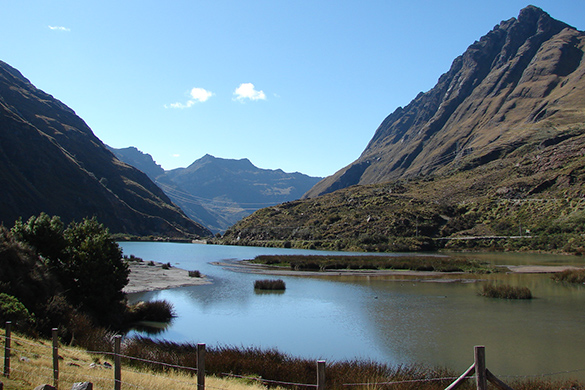
Contaycocha is a lake located downstream of the Huanzala Mine, and it was unable for living things to inhabit because of the acidic water discharged from the mine. In addition to water quality improvement through acidic water treatment, Minera Santa Luisa worked on environment restoration such as water sealing of acidic sediment by raising the embankment and soil covering and tree planting. As the result, trout and waterfowls have returned to the lake as the water quality and the surrounding environment have been restored.
Mine Closure Plan
Since mineral resources are limited, environmental management after mine closure is indispensable for maintaining the surrounding environment. However, quite a few mines had been abandoned and affected the environment in history.
We have drawn up closure plans of mines subject to applicable laws and guarantee or accumulate expenses for closure to minimize the environmental and social risk after closure.
The following items are defined as goals in the closure plan;
・Priority on preserving the environment and compliance with local laws and regulations
・Landform stabilization to prevent pollution and physical and chemical containment of emissions
・Development of a versatile closure plan that allows for introduction of technical innovation and new technologies
・Environmental restoration for utilization and conservation of the land after closure
・Implementation of management measures for the social, economic, and organizational development of the local communities affected by mine operations
In Peru, the Law of Mine closure was promulgated in 2003, which required mines in operation and mine development projects to submit a closure plan and to accumulate the closure costs based on the plan.
The Huanzala Mine conducted voluntary pre-survey in 2004 prior to the law enforcement and started assessing and developing a closure plan. The Pallca Mine also developed a mine closure plan. In 2009, both mines obtained government approvals for the closure plan and guarantee closure costs and have since renewed those approvals multiple times.
We have been conducting works for mine closure in advance at both mines, including removal of waste rock that causes acid water, closure of surface water intrusion routes, separation of mine drainage into contaminated and clean water, and soil-covering/planting at the waste rock deposition site. In addition, we regularly receive audits of these works by government agencies.
The survey results of the closure plan during the evaluation period are directly distributed to the local communities experiencing social impacts from the mine, and are also published on the Ministry of Energy and Mines’ website. Opinions and suggestions from the local communities regarding the closure plan are collected by the ministry, and information on our responses to the aggregated opinions and suggestions is provided to the local communities through the ministry’s publications.
We implement works for mine closure in advance at the Huanzala Mine and the Pallca mine. We work on removal of waste rock generated in the past operation and soil-covering/planting grass at the Huanzala Mine
left:Before soil-covering/planting grass(Huanzala, 2007) right:After (Huanzala, 2019)

Advancing soil cover and grass planting after the removal of waste rock(Pallca Mine)
Management of Suspended and Closed Mines
Mitsui Kinzoku continues management of suspended and closed mines, in accordance with the Mine Safety Act and applicable environmental laws and regulations. This includes regular patrols and inspections of managed sites, water quality monitoring in surrounding areas, drain maintenance, and soil covering and planting to maintain the surrounding environment.
At managed sites where contact between rainwater or groundwater and tailings or metal-containing rocks generates acidic water with heavy metals, we have installed mine wastewater treatment facilities to treat the water to levels that meet government standards.
At some managed sites, we conduct mine wastewater treatment without using chemicals and external energy supply, thereby contributing to the reduction of environmental impact.
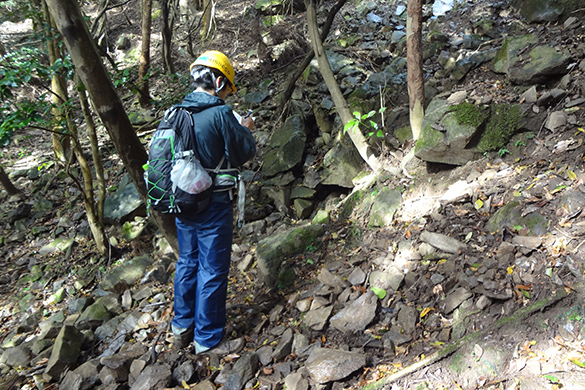
We patrol suspended and closed mines on a regular basis to confirm that there are no hazardous spots, such as new caved-in hole in which people may fall.

At sites where acidic water is generated, we manage and conduct regular inspections of the mine wastewater treatment facilities.
At the Udo Mine, the mine wastewater treatment facilities operate automatically. The operational status can be monitored remotely, and in the event of an anomaly, alerts are sent to staff who promptly head to the site to address the issue.
(left: The neutralization tank of mine wastewater treatment facility right: The facility control panel)

We reduce the amount of acidic water generated by maintaining drainage channels at tailings dams and former mining sites, thereby minimizing the contact between rainwater and tailings or rocks containing heavy metals.

Preparing for recent extreme weather events, we are developing emergency response manuals, ensuring the capacity of mine wastewater storage tanks, and exploring methods to secure power sources during prolonged power outages.
Water Management
In the underground of the Huanzala Mine, acidic water generates due to an abundance of sulfide of iron in ore.
Applying mine pollution prevention technology in Japan, Compania Minera Santa Luisa built a mine-attached neutralization plant in 1998 that was the first one in Peru. The mine continued to improve the plant by increase of settling tanks/clarifiers, betterment of lime addition pumps and enlarging oxidation blowers, and keep processing stable acidic water treatment.
We continue to remove waste rock containing sulfide of iron that has been piled up on the ground surface over the past 16 years, reducing the generation of acidic water by cutting off its contact with rainwater.
A 24-hour monitoring system of mine drainage water is put into place, thus it is consistently ascertained that the pH level and flow rate of the water released into the river is within the range of effluent standards.
Furthermore, we voluntarily conduct survey every three days in order to check the concentration of heavy metals within the drained water. In addition, water samples are collected from locations around the Huanzala Mine once every week to check the water quality in accordance with related laws. The flotation plant at the Huanzala mine is also advancing efforts to recycle water and striving to reduce water consumption.
Additionally, the flotation plant at the Huanzala Mine is promoting the recycling of water within the process and the reuse of water from the tailings dam.
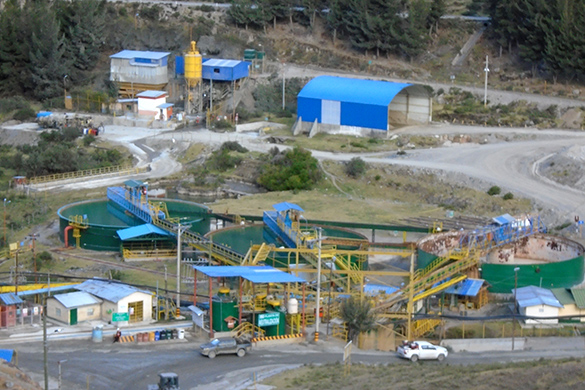
The neutralization plant of Huanzala. After neutralization, the supernatant water is discharged into the river with pH level and heavy metal content within the range of effluent standards and the sediment is stored in the tailings dam. The processing capacity of the plant is 15 m3 / min.
Tailings Dams Management
In the flotation process, slurry type wastes called tailings are generated. The facility to storage “tailings” is called “tailings dam”. In recent years, a series of dam collapses occurred in Brazil and Canada, and they have been considered as significant environmental and social issues. Mitsui Kinzoku Group regards the management of tailings dams as one of the major risks in the mining business and manages them in accordance with applicable technical guidelines and manuals.
Japan
In Japan, there were leakage incidents at a number of tailings dams caused by the Great East Japan Earthquake in 2011. Then in 2012, the ministry of Economy, Trade and Industry revised the Technical Policies of the ministerial decree defining technical standards of mining facilities (called "Technical Policies" hereafter). We recognize that the Technical Policies is an important guideline for ensuring the safety of tailings dams in Japan, which have relatively high risks of earthquakes, and we manage tailings dams in accordance with these Technical Policies.
In 1998, we conducted voluntary stability evaluations of the top three tailings dams out of 13 dams managed by Mitsui Kinzoku after the Han-Shin Awaji Earthquake disaster in 1995. As a result, we confirmed these three dams would remain stable even in the event of a massive-scale earthquake (Level 2 earthquake).
We also evaluated the stabilities of five dams in line with the revision of Technical Policies from 2012 to 2015 that were subject to Technical Policies requirements, and ascertained they have extremely low risks of major collapse in the event of Level 2 earthquake.
Furthermore, we have been evaluating five dams since 2017 that were not subject to the Technical Policies, and have confirmed four of them have the earthquake resistance. The remaining one was found to be non-conforming by an evaluation in FY2019 and seismic reinforcement constructions were completed in FY2021.
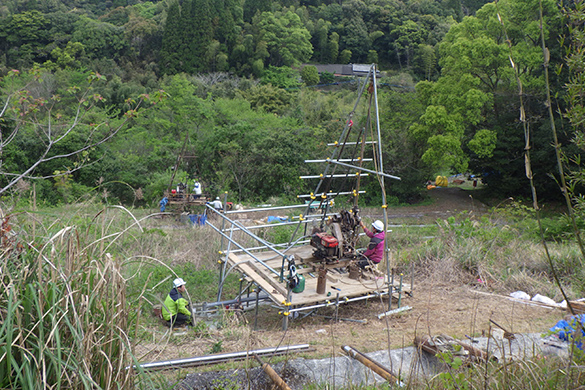
In stabilization surveys of a tailings dam, we dig observation well and measure the groundwater level to check seepage into dam embankment.
Peru
In Peru, Compania Minera Santa Luisa designs, manages and conducts stability evaluations of tailings dams in accordance with the technology guidelines and manuals defined by the Ministry of Energy and Mines. Peru is a country with a relatively high risk of earthquake like Japan.
As a result of stability evaluation, it has been confirmed that the tailings dam of the Huanzala mine has no problems and will remain stable, even if the area is hit by a major earthquake of a level that only happens once every 475 years.
To ensure the safety, in-house engineers conduct monthly monitoring of the seepage level gauges in the levees, strain gauges, and inclinometers. Additionally, external specialists audit the in-house monitoring results and conduct their own inspections.
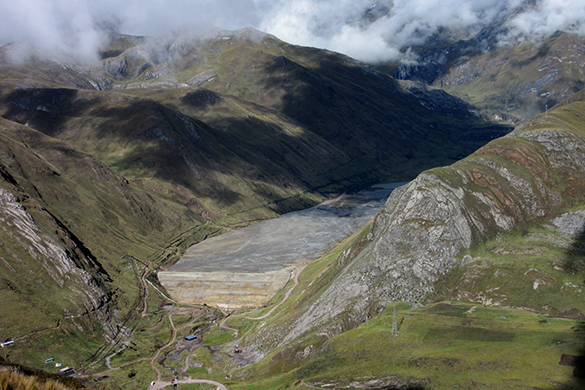
Chuspi, the tailings dam of the Huanzala Mine. a stability analysis was conducted by external consultants in 2024, confirming that it would remain stable, even if a major earthquake hit the area.
The list of tailing dams managed by Mitsui Kinzoku Group
In June 2019, Mitsui Kinzoku disclosed information about abandoned tailings dams based on requests from the British Church Pension Committee and the Swedish National Pension Fund Moral Committee.
Information Concerning Tailings Dam management
Use of Security Companies
At some of our sites, we use security companies to protect the safety of employees. We are aware of the inherent risk to human rights related to the use of weapons for security.
Regarding the use of security personnel, we will comply with local laws and regulations and respect international principles such as the Voluntary Principles on Security and Human Rights, and establish a security system based on the Human Rights Policy of Mitsui Kinzoku Group.
We have contracted a consulting firm specialized in sustainability and ESG management services to conduct a business risk assessment in line with the Voluntary Principles on Safety and Human Rights at our site in Peru.
Relationships with the Local Communities
Compania Minera Santa Luisa strives to establish relationships of co-existence and mutual prosperity with the local communities.
In order to provide more effective community support, we have selected the pastoral support that we have been working on for many years as a focused area and are now conducting an impact assessment.
The Huanzala mine and the Pallca mine have concluded regional assistance agreements with local governments in order to support local governments and residents. Compania Minera Santa Luisa has provided various community supports such as direct support for local communities and indirect support through infrastructure investment.
| Local community support |
|
Free supply of electricity from company-owned hydroelectric power stations.
Education support
- Donation of school supplies, PCs, tablets, and books
- Job training and employment supports
- Construction of schools
Medical support
- Donation of medical implements
- Free examinations
- Donation of an ambulance, an oxygen plant, disinfectant, masks, etc. to counter COVID-19
Livestock industry support
- Improvement of the breed of domestic animals
- Distribution of seeds
- Instructions on livestock industry
- Donation of agriculutural tractors
|
| Investment in infrastructure |
Construction of roads
- Catac road(from Pacific coast to Huanzala mine)
- Pallca-Chiquian road(from Chiquian town to Pallca mine)
Development of local communities’ infrastructure
- Construction of bridges, water and sewage facilities, and administrative offices, etc.
Improving housing for local residents
- Support for the relocation of residence in landslide area
|
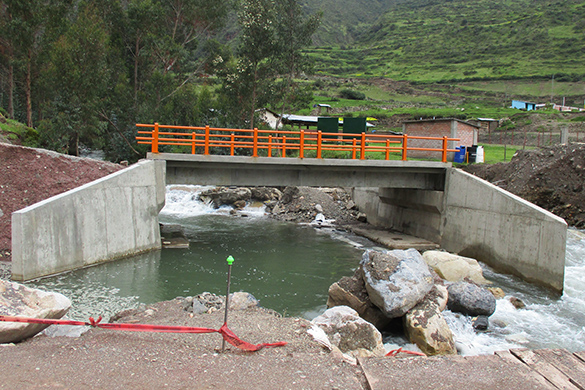
Construction of a bridge in a neighboring village. Infrastructure investments create jobs in local communities and revitalize the local economy.
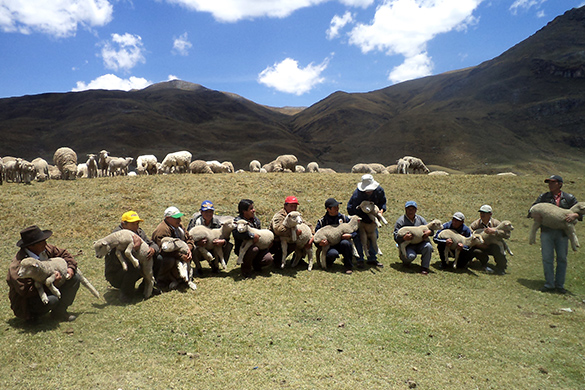
The supports for the agriculture and livestock industry are important measures to revitalize the local communities; We provide technical supports by specialists and veterinarians. We artificially inseminate cattle to improve livestock breeds and lend studhorses and sheep propagated in our own farm to the local farmers.
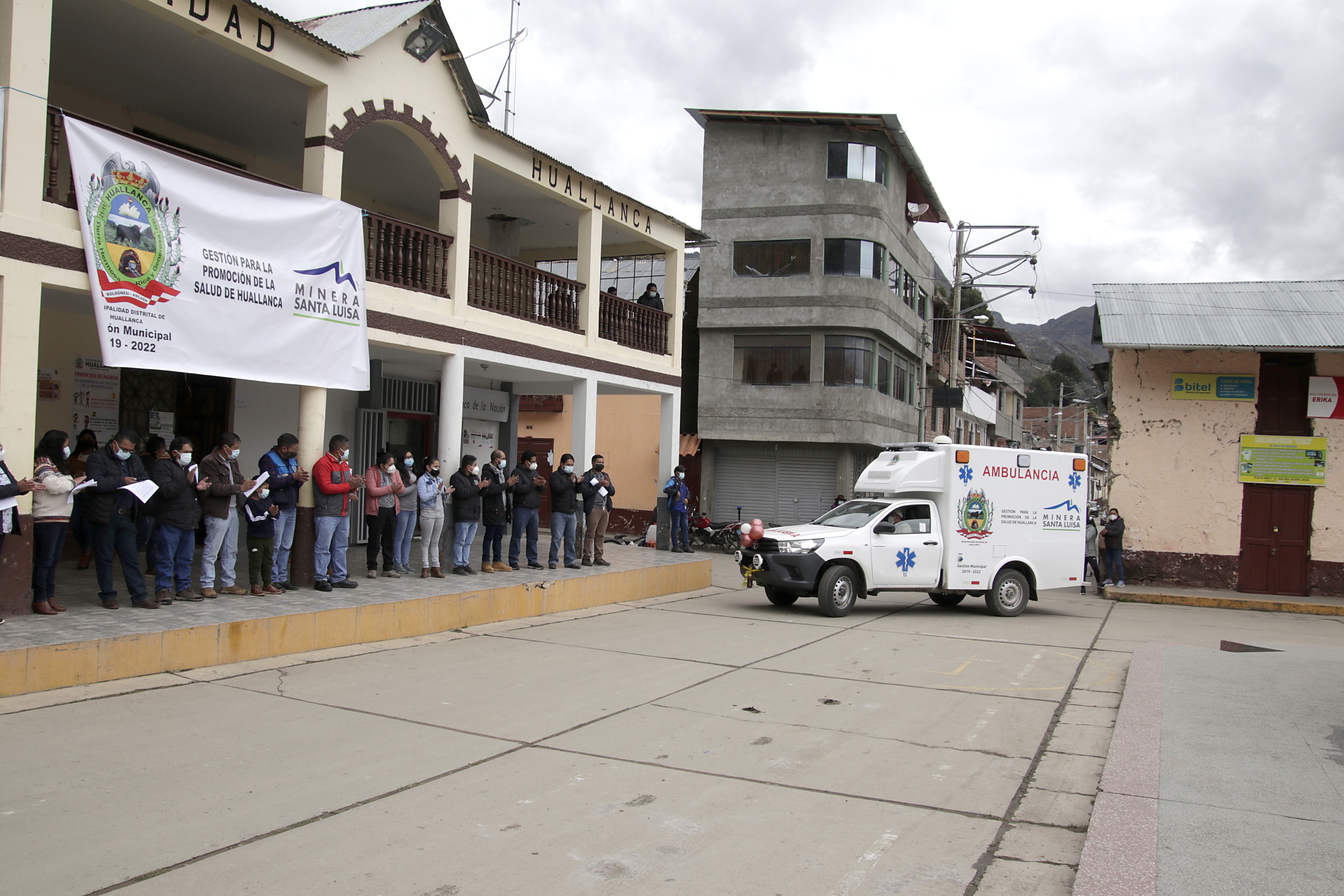
Providing an ambulance to Huallanca Village; providing medical assistance including support for COVID-19 measures.
Biodiversity
Integrated Report Mining business [PDF:1,472KB]pages 83-85